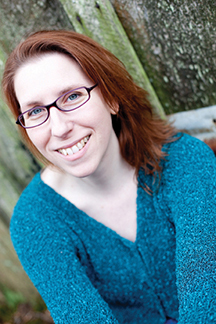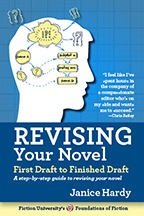Keep Your Readers Hooked by Dropping the Right Clues

By Janice Hardy, @Janice_Hardy
Foreshadowing might seem like a technique that applies mostly to mystery writers, but all stories rely on the classic “what might happen next?” question. Even in a romance, there are secrets to be revealed and histories to uncover, and where that information is learned affects a novel’s pacing. It’s the need to know that draws readers in and keeps them reading. Drop the right clues at the right time and readers will be glued to the pages.
Well-crafted foreshadowing puts those readers in the right mindset long before they reach a scene, and makes them anticipate that scene. Secrets unfold in surprising, yet inevitable ways, and readers feel as though the clues were there all along if only they’d seen them—because they were.
Too much too soon and there’s nothing left to learn (and no reason to read). Too little for too long risks frustrating readers, because they never learn anything new.
No matter what type of mystery your novel uses, look at where your clues and foreshadows appear. If you’re unsure how these elements should unfold, consider:
When and where you want readers to start suspecting the truth: Establishing patterns is a useful foreshadowing technique. Tension builds when readers are expecting something and waiting eagerly for it to happen.
Don’t forget the value of the Rule of Three here:
The first time someone sees something, they merely see it.
The second time, they notice it, because it stands out now.
The third time, they’re looking for it because you’ve established a pattern to anticipate.
For example, if you want to foreshadow a misunderstanding that has dire consequences, you might have the protagonist misunderstand something minor in the first few chapters. Later on, she might get something else wrong due to distraction. Now you’ve established a pattern that the protagonist doesn’t always listen and misunderstands what she hears. Readers will be looking closely at all her assumptions from then on to see if she’s missing something important. When the big moment occurs, tensions will be higher because readers won’t know if she’s right this time, or if she’s missed something yet again.
Or you might drop hints about an item to be used later. When the protagonist arrives at a quaint bed and breakfast for a yoga retreat, she is surprised to see a shotgun hanging above the fireplace and makes a comment. The next guest to arrive notices the gun and makes a joke about it. When the third guest arrives, readers expect the gun will come up again. And that will make them wonder when, where, and how that gun will be used in the story.
Or, you can be more subtle about it and tap into a reader’s subconscious. Say you want to foreshadow that blue means bad. You might have the protagonist get into an accident with a blue car early on. Then she has a run in with an office rival who knocks blue ink all over her. You might toss in her snagging her new blue skirt and tearing it right before she goes into an important meeting. After that three-step setup, readers will be looking for blue things and anticipating the problems they might cause.
These types of hints can happen over the course of one scene or the whole novel. It’s the creak in the night, followed by the thump, followed by the guy in the ski mask jumping out at you.
When and where you want the protagonist to start figuring it out: Readers often spot details long before characters do, but if the clues are too obvious, then the characters look dumb if they haven’t figured them out as well. Check to make sure you have a good balance between reader hints and character hints. If your protagonist needs to know something by page 45, make sure you’ve left enough clues so the realization feels plausible.
One mystery-writer’s trick is to hide important clues in the middle of the paragraph. Readers don’t pay as much attention to what’s in the middle of a paragraph, but they do focus on the beginning and end of that same paragraph. So they see it, but it often doesn’t jump out at them.
Beware of foreshadowing too much. If you’re dropping clues every chapter, readers will figure out the secret long before they get to the reveal.
Adding suggestive and evocative details: There have been a slew of movies, TV shows, and Vegas acts that have the protagonist—usually some type of con man—setting up a mark (the victim) to think or respond a certain way. They use subliminal clues to suggest what they want the mark to think or say. Drop enough clues with the numbers three and six in front of someone, then ask them to pick a number between ten and forty, and you’ll get a lot of thirty-sixes.
To put ideas in readers’ heads, plant a few suggestive clues. Don’t explain or draw attention to any of them, but if you want readers to think “blue means bad,” then put in something blue whenever something bad happens. Associate blue with bad in their minds, so by the time your protagonist reaches why blue is bad, readers will already feel apprehensive.
Foreshadowing is a handy way to raise tensions, and a well-planned story puzzle leaves lots of clues that readers can look back on and see that the answers were there the whole time.
Do you plan your foreshadowing or does it happen naturally?
Win a 10-Page Critique From Janice Hardy
Three Books. Three Months. Three Chances to Win.
To celebrate the release of my newest writing books, I’m going on a three-month blog tour–and each month, one lucky winner will receive a 10-page critique from me.
It’s easy to enter. Simply visit leave a comment and enter the drawing via Rafflecopter. At the end of each month, I’ll randomly choose a winner.
Looking for tips on revising your novel? Check out my new book Revising Your Novel:
First Draft to Finished Draft , a series of self-guided workshops that help you revise your manuscript into a finished novel. Still working on your idea? Then try my just-released Planning Your Novel Workbook .
 Janice Hardy is the award-winning author of The Healing Wars trilogy and the Foundations of Fiction series, including Planning Your Novel: Ideas and Structure, a self-guided workshop for planning or revising a novel, the companion Planning Your Novel Workbook, Revising Your Novel: First Draft to Finished Draft and the upcoming Understanding Show, Don’t Tell (And Really Getting It). She’s also the founder of the writing site, Fiction University. For more advice and helpful writing tips, visit her at www.fiction-university.com or @Janice_Hardy.
Janice Hardy is the award-winning author of The Healing Wars trilogy and the Foundations of Fiction series, including Planning Your Novel: Ideas and Structure, a self-guided workshop for planning or revising a novel, the companion Planning Your Novel Workbook, Revising Your Novel: First Draft to Finished Draft and the upcoming Understanding Show, Don’t Tell (And Really Getting It). She’s also the founder of the writing site, Fiction University. For more advice and helpful writing tips, visit her at www.fiction-university.com or @Janice_Hardy.
Website | Facebook | Twitter | Goodreads | Amazon | Barnes & Noble | iTunes | Indie Bound
*Excerpted from Revising Your Novel: First Draft to Finished Draft
3 things to consider when using foreshadowing (from @Janice_Hardy):
Click To Tweet
The post Keep Your Readers Hooked by Dropping the Right Clues appeared first on Elizabeth Spann Craig.




